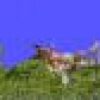Free Online Productivity Tools
i2Speak
i2Symbol
i2OCR
iTex2Img
iWeb2Print
iWeb2Shot
i2Type
iPdf2Split
iPdf2Merge
i2Bopomofo
i2Arabic
i2Style
i2Image
i2PDF
iLatex2Rtf
Sci2ools
CVPR
2008
IEEE
2008
IEEE
Unsupervised discovery of visual object class hierarchies
Objects in the world can be arranged into a hierarchy based on their semantic meaning (e.g. organism ? animal ? feline ? cat). What about defining a hierarchy based on the visual appearance of objects? This paper investigates ways to automatically discover a hierarchical structure for the visual world from a collection of unlabeled images. Previous approaches for unsupervised object and scene discovery focused on partitioning the visual data into a set of nonoverlapping classes of equal granularity. In this work, we propose to group visual objects using a multi-layer hierarchy tree that is based on common visual elements. This is achieved by adapting to the visual domain the generative Hierarchical Latent Dirichlet Allocation (hLDA) model previously used for unsupervised discovery of topic hierarchies in text. Images are modeled using quantized local image regions as analogues to words in text. Employing the multiple segmentation framework of Russell et al. [22], we show that meaningf...
Common Visual Elements | Computer Vision | CVPR 2008 | Meaningful Object Hierarchies | Multi-layer Hierarchy Tree | Unsupervised Object | Visual Objects |
Related Content
| Added | 12 Oct 2009 |
| Updated | 28 Oct 2009 |
| Type | Conference |
| Year | 2008 |
| Where | CVPR |
| Authors | Josef Sivic, Bryan C. Russell, Andrew Zisserman, William T. Freeman, Alexei A. Efros |
Comments (0)

